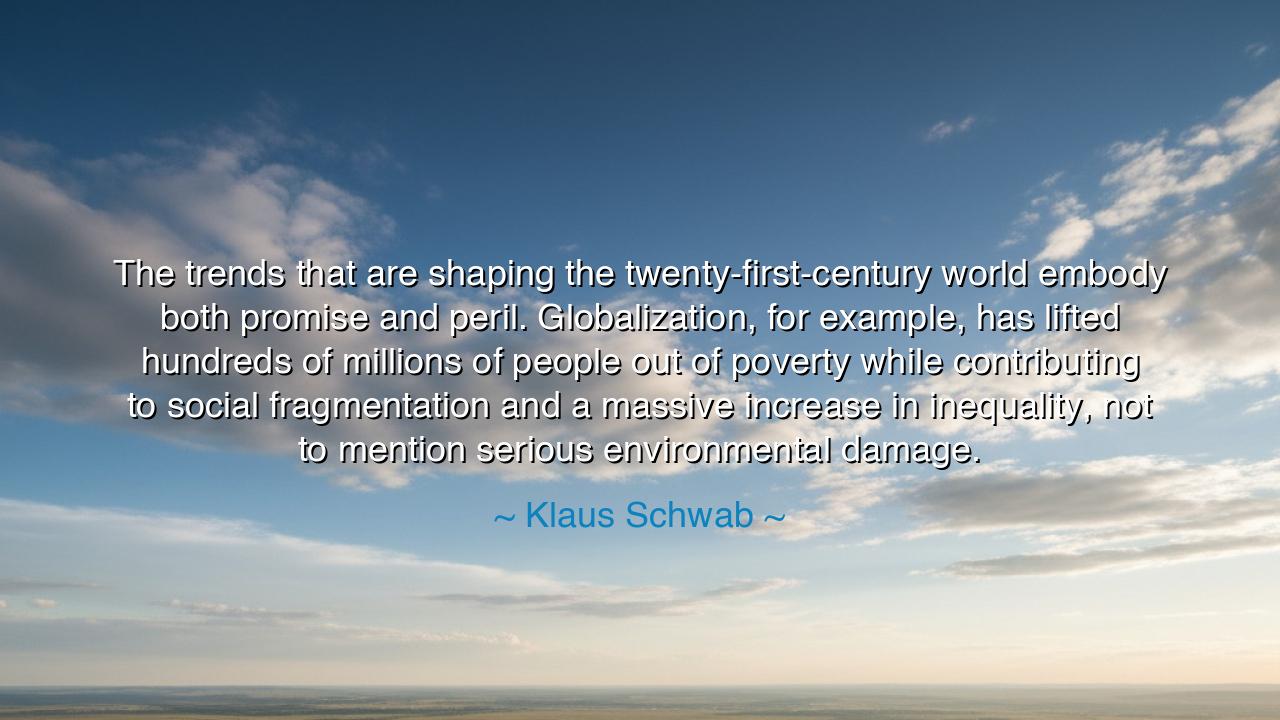
The trends that are shaping the twenty-first-century world embody
The trends that are shaping the twenty-first-century world embody both promise and peril. Globalization, for example, has lifted hundreds of millions of people out of poverty while contributing to social fragmentation and a massive increase in inequality, not to mention serious environmental damage.






In the ledger of our age, Klaus Schwab writes a sober line: “The trends that are shaping the twenty-first-century world embody both promise and peril. Globalization, for example, has lifted hundreds of millions of people out of poverty while contributing to social fragmentation and a massive increase in inequality, not to mention serious environmental damage.” Hear how the sentence carries two scales—one heaped with gain, the other with grief. It is a warning to walkers on a ridge: the view is grand, the footing treacherous, and the path demands both courage and care.
The ancients would call this the law of the double-edged sword. Tools that magnify our reach also magnify our mistakes. Globalization has delivered medicines faster than caravans ever dreamed, stitched markets together like a new silk road, and turned distant strangers into neighbors of the mind. Yet the same loom can fray the village—traditions thinned, wages pressed, identities shaken—as wealth gathers like rain in a few cisterns while many fields crack. Thus promise and peril travel as twins, and wisdom is the art of keeping them from devouring each other.
Consider a true and mighty tale: as borders of trade opened and supply chains lengthened, factories rose and with them incomes for families who had long counted coins at dusk. In parts of East and South Asia, a generation leapt from subsistence to schooling, from dim lamps to bright clinics. This was promise fulfilled—poverty broken by enterprise and exchange. But the ledger’s other side is written too: industrial towns wrapped in smog; rivers the color of their dye-houses; land made restless by the hunger of distant markets. The same currents that carried prosperity also carried environmental damage, and the bill arrived with interest.
Another chapter is bound in thread and grief: when the Rana Plaza building collapsed in Bangladesh, the world learned that cheap shirts can cost dear lives. Here was inequality in concrete and dust—buyers buffered by distance, makers trapped by need. Out of the ruin came reforms—audits, accords, safer standards—proof that markets can grow a conscience when pushed by witness. But the parable endures: without vigilance, social fragmentation widens—between those who choose and those who must, those who profit and those who pay.
We have seen the same tension in distant forests and near screens. The appetite of global demand bites into the green bones of the earth—trees fall to soybean and cattle, mines unspool beneath clouded skies, seas grow warm and swollen. Meanwhile, the digital bazaar connects minds yet sometimes sunders hearts, sorting us into echoing crowds where anger is a currency. The gifts of the twenty-first-century—speed, scale, data—can nurse community or gnaw it, depending on the hands that wield them and the rules that bind those hands.
What wisdom, then, shall we pass down? That stewardship must grow as swiftly as power. We must price not only what we sell but what we spoil; count not only GDP but the health of air, water, and trust. Let Globalization be a bridge, not a siphon. Tie capital to conscience, innovation to inclusion, trade to treaties that defend both worker and watershed. Refuse the lazy comfort of single stories—neither hymn nor dirge alone will serve. Hold both—the lift and the loss—until policy and practice can honor the whole.
Take up these plain, practicable rules: (1) Build supply chains that are traceable end-to-end; buy where wages are living and safeguards real. (2) Anchor growth to carbon budgets and circular design so environmental damage is cut at the root, not bandaged at the branch. (3) Share the gains—profit-sharing, worker ownership, portable benefits—so inequality does not harden into fate. (4) Invest in local culture and skills, that social fragmentation may be mended by dignity at home. (5) Measure what matters—wellbeing, resilience, ecological integrity—and let those measures steer both boardroom and ballot. Walk thus, and the blade that now glitters with promise will cease to wound with peril; it will become a tool fit for builders, not conquerors.






AAdministratorAdministrator
Welcome, honored guests. Please leave a comment, we will respond soon